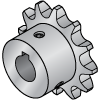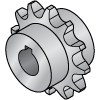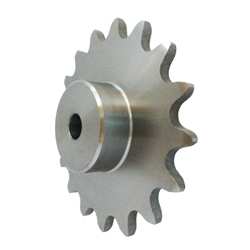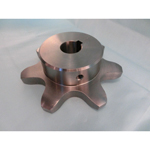(!) Since support from Microsoft will end on January 14 2020, Windows 7 user might not be able to use MISUMI website effectively. Please consider to update your system as ‘MISUMI Website system requirement’.
- แจ้งวันหยุดทำการในเดือน พฤษภาคม 2567 | Notice holiday in May 2024 > คลิก
Sprockets(Nominal Number:C2102H)
Chain sprockets are mechanical components used in combination with chains to enable drive forces to be transmitted via a chain. The sprocket teeth engage with the chain links to establish a connection between the sprocket and the chain. When selecting a sprocket, it is crucial to consider factors such as Sprocket Shape (eg. Type A, Type B, Type C) , Size, Number of Teeth, Shaft Bore Diameter, material, and so on. These considerations are vital to ensure the production of high-quality products. We highly recommend reputable brands like MISUMI, TSUBAKIMOTO, and SANKOSEISAKUSHO for their quality and reliability. Additionally, cost-effective options from MISUMI ECONOMY are available for those seeking economical solutions. Take advantage of the convenience of free shipping and no minimum order when purchasing sprockets. If you have any doubts or require assistance in choosing the right product, our experts are readily available to assist.
Configure
Specification/Dimensions
-
Sprocket Shape
-
 Shape A
Shape A -
 Shape B
Shape B -
 Shape C
Shape C -
 Shape SD
Shape SD
-
-
Nominal Number
-
Number of Teeth(T)
-
Shaft Bore Dia. d(mm)
- 4
- 5
- 6
- 7
- 8
- 9
- 9.53
- 10
- 10K
- 11
- 12
- 12.7
- 13
- 14
- 15
- 16
- 17
- 18
- 19
- 20
- 21
- 22
- 23
- 24
- 25
- 26
- 27
- 28
- 29
- 30
- 31
- 32
- 33
- 34
- 35
- 36
- 37
- 38
- 39
- 40
- 41
- 42
- 43
- 44
- 45
- 46
- 47
- 48
- 49
- 50
- 51
- 52
- 53
- 54
- 55
- 56
- 57
- 58
- 59
- 60
- 61
- 62
- 63
- 64
- 65
- 66
- 67
- 68
- 69
- 70
- 71
- 72
- 73
- 74
- 75
- 76
- 77
- 78
- 79
- 80
- 81
- 82
- 83
- 84
- 85
- 86
- 87
- 88
- 89
- 90
- 91
- 92
- 93
- 94
- 95
- 96
- 97
- 98
- 99
- 100
- 101
- 102
- 103
- 104
- 105
- 106
- 107
- 108
- 109
- 110
- 111
- 112
- 113
- 114
- 115
- 116
- 117
- 118
- 119
- 120
- 121
- 122
- 123
- 124
- 125
- 126
- 127
- 128
- 129
- 130
- 131
- 132
- 133
- 134
- 135
- 136
- 137
- 138
- 139
- 140
- 141
- 142
- 143
- 144
- 145
- 146
- 147
- 148
- 149
- 150
- 151
- 152
- 153
- 154
- 155
-
Number of Strands
- 1
- 2
-
Material
- Steel
- Stainless Steel
-
Chain Type
-
Type
- Pilot Hole Type
- Shaft Bore Machined Type
- Keyless Type
-
Shaft Type
-
Surface Treatment
-
Roller Type
Brand |
|
|---|---|
| CAD |
|
| Days to Ship |
|
- 2 items
- Sort By
-
You can add up to 6 items per a category to the compare list.

Standard 2102 Double Pitch Sprocket, R Roller B Type
KATAYAMA CHAIN
Rich lineup of variations in KANA standard sprocket count, number of teeth, and shape. The shaft holes of this product are not yet machined, so machining of shaft holes is required when using.From: ฿ 4,541.17 Days to Ship: 10 Day(s)
10 Day(s)
-
You can add up to 6 items per a category to the compare list.

KATAYAMA CHAIN
The semi-F series is a system for simple set up and rapid delivery of completed products with the desired machining (internal diameter, keyway, tap) of products with pilot holes completed.From: ฿ 7,100.32 Days to Ship: 10 Day(s)
10 Day(s)
| Brand |
|---|
| Product Series |
| CAD |
| From |
| Days to Ship |
| Sprocket Shape |
| Nominal Number |
| Number of Teeth(T) |
| Shaft Bore Dia. d(mm) |
| Number of Strands |
| Material |
| Chain Type |
| Type |
| Shaft Type |
| Surface Treatment |
| Roller Type |
You can add up to 6 items per a category to the compare list. | You can add up to 6 items per a category to the compare list. | |
| Brand | KATAYAMA CHAIN | KATAYAMA CHAIN |
| Product Series | ||
| CAD |
|
|
| From | ฿ 4,541.17 | ฿ 7,100.32 |
| Days to Ship | 10 Day(s) | 10 Day(s) |
| Sprocket Shape | Shape B | Shape B |
| Nominal Number | C2102H | C2102H |
| Number of Teeth(T) | 10 ~ 12 | 10 |
| Shaft Bore Dia. d(mm) | 35 | 53 |
| Number of Strands | 1 | 1 |
| Material | Steel | Steel |
| Chain Type | Double Pitch | Double Pitch |
| Type | Pilot Hole Type | Shaft Bore Machined Type |
| Shaft Type | Standard Pilot Bore | Shaft Bore Machining Configurable |
| Surface Treatment | Not Provided | Not Provided |
| Roller Type | R Roller | R Roller |
Loading...
Application example related to this category
Related Categories to Sprockets
FAQ Sprockets
- Question: What are sprockets and how are they used in mechanical systems?
- Answer: Chain sprockets are mechanical components used in combination with chains to enable drive forces to be transmitted via a chain. The sprocket teeth engage with the chain links to establish a connection between the sprocket and the chain. Sprockets are crucial elements in the design and mechanics of machines and systems, indispensable for the mechanical transmission of movement and force, for example, in chain conveyors, packaging machines, and printing presses.
- Question: Can you explain the different types of sprockets, such as A, B, and C types?
- Answer: Chain sprockets are categorized into four main types of sprockets as established by the American National Standards Institute (ANSI):
1. Type A sprockets have no hubs, consisting solely of the plate with teeth.
2. Type B sprockets have a hub on one side for heavy loads and larger systems.
3. Type C sprockets, which have hubs of equal thickness on both sides of the plate for heavy loads and larger systems.
4. Type C (Offset) sprockets, also referred to as Type D, have two unequal-sized hubs, forming an asymmetric sprocket The choice of sprocket type depends on the specific requirements of the machine or system, such as space constraints, load capacity, and desired performance characteristics. - Question: What materials are commonly used to manufacture sprockets, and why?
- Answer: Chain sprockets are commonly manufactured using various materials, each chosen for specific applications and performance characteristics. The most common materials for chain sprockets include:
1.Carbon Steel: Suitable for solid sprockets in non-corrosive environments. It offers good wear resistance and is cost-effective.
2.Stainless Steel: Used for solid sprockets in corrosive environments. It provides excellent corrosion resistance and durability, such as in vegetable processing.
3.Plastic (UHMW Polyethylene and Nylon): These materials are used for sprockets in food processing and other industries where cleanliness and low friction are important. UHMW Polyethylene can withstand continuous temperatures up to 180°F, while Nylon sprockets provide 2-3 times the strength of UHMW and can withstand higher temperatures - Question: How does the number of teeth on a sprocket affect its performance?
- Answer: The number of teeth on a chain sprocket significantly impacts its performance. More teeth result in higher torque but lower speed, while fewer teeth lead to higher speed but less torque, following gear ratio principles. This choice affects wear and durability, as fewer teeth concentrate load, potentially increasing wear, while more teeth distribute load, enhancing durability. Additionally, sprockets with more teeth often provide smoother motion, reducing noise and vibration. Spatial constraints within the system must also be considered. Overall, the number of teeth on a chain sprocket is critical, influencing torque, speed, wear, durability, smoothness of operation.
- Question: What should be considered when selecting a sprocket for a specific application?
- Answer: Factors to consider when selecting a chain sprocket:
1. Chain Size: Ensure compatibility with the chain's size, pitch, and width for proper engagement and wear prevention.
2. Number of Teeth: Determine the appropriate number of teeth to balance speed, torque, and efficiency, considering the input-output relationship.
3. Material: Choose the sprocket material based on environmental conditions, load capacity, temperature range, and chemical resistance. Options include carbon steel, stainless steel, and plastic.
4. Shaft Size: Ensure compatibility with shaft size and type.
5. Alignment: Properly align the sprocket with the chain and other system components to prevent premature wear and ensure optimal performance.
6. Lubrication: Use appropriate lubrication compatible with the sprocket material and environmental conditions to prevent wear and extend the life of the chain and sprocket. - Question: How does the material of a sprocket influence its strength and friction resistance?
- Answer: When selecting material for chain sprockets, several key factors must be considered:
1. Selection Criteria: Material choice based on environmental conditions, load capacity, temperature range, and chemical resistance.
2. Strength and Friction Resistance: Material choice significantly impacts these characteristics.
3. Hardening Process: Essential for enhancing wear resistance and shock load absorption in sprocket teeth.
4. Optimization: The right material and hardening process optimize strength and friction resistance for specific applications.
















How can we improve?
How can we improve?